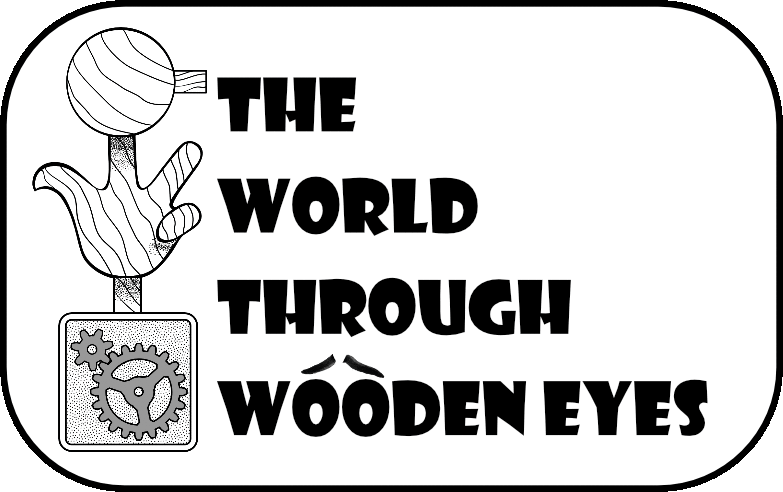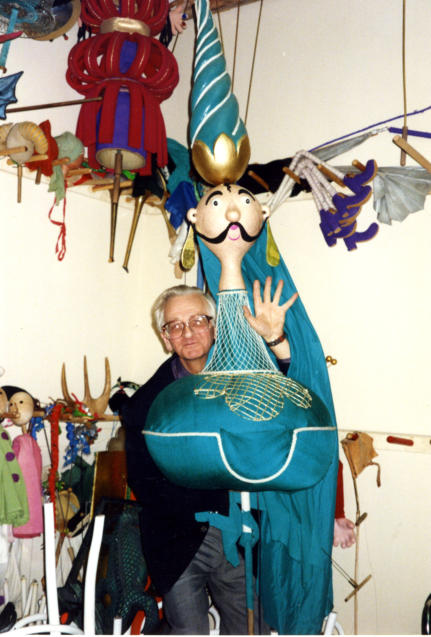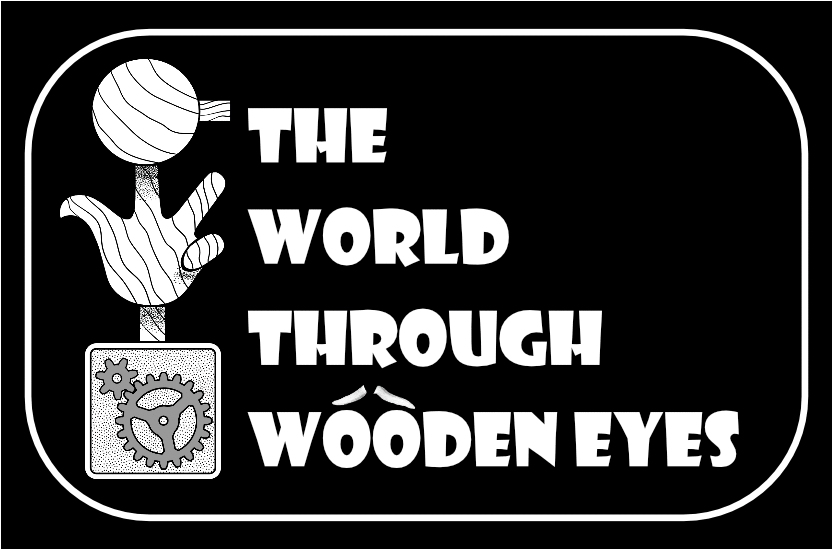NAVIGATION
SOCIAL
CONTACT
e-mail: info@theworldthroughwoodeneyes.co.uk

The
puppet
theatre
in
Poland
has
proved
to
be
a
distinctive
and
exceptionally
rich
area
for
stage
design,
and
has
consequently
grown
into
a
flourishing
art.
The
roots
of
Polish
puppet
theatre
reach
way
back
into
the
past
-
to
the
medieval
"szopka"
a
church-like
structure
in
which
simple
effigies
and
later
puppets,
performed
the
Christmas
Nativity
story.
Polish
puppet
theatre
design
has
a
very
distinctive
style,
the
result
of
experiments,
which
have
dealt
with
artistic
rather
than
technical
problems.
This
has
resulted
in
more
interesting
unified
design
styles
which
have
established
a
unique
and
sophisticated
form
of
modern
creative
puppet
theatre
dealing
with
complex
and
difficult
conventions
which
children
accept
thus
providing
them
with
an
aesthetic
education
which
develops
a
great
love
for
the
theatre
and
the
arts
in
general.
The
puppet
theatre
is
often
referred
to
as
the
designer’s
theatre,
and
nowhere
has
this
been
confirmed
with
greater
certainty
than
Poland
where
puppet
theatre
performances
are
notable
for
the
remarkable
range
of
imaginative
ideas
produced by the designers.
For
many
years
one
man
dominated
the
design
scene
in
Poland,
both
in
the
puppet
theatre
and
the
theatre
of
drama,
opera
and
dance
-his
name
-
Adam
Kilian.
It
is
impossible
to
do
justice
to
this
exceptionally
talented
man,
in
print.
At
first
glance
his
work
appears
to
be
very
simple,
highly
imaginative,
colourful,
and
possessing
the
finest
qualities
usually
associated
with
the
work
of
children
and
folk
artists.
He
could
be
described
as
a
Peter
Pan
character,
he
never
seems
to
grow
old,
he
never
changes,
is
always
on
the
move,
continuously
excited
by
the
child’s
creative
work
and
play,
folk
art,
classical and modern art, and always fascinated by modern fashion which he calls modern folk art.
The
work
of
Adam
Kilian
stands
out
against
that
of
many
other
original
and
talented
Polish
designers.
He
has
been
connected
with
and
surrounded
by
art
and
artists
all
his
life.
His
mother,
Janina
Kilian-Stanislawska,
was
a
leading
art
critic,
director
of
the
Krakow
Children’s
Puppet
Theatre,
and
later,
the
renowned
Lalka
Theatre,
Warsaw,
one
of
the
worlds
most
influential
puppet
theatres.
His
aunt,
Zofia
Stanislawska-Howurkowa
was
a
fine
sculptor,
graphic
artists
and
stage
designer.
So
this
was
his
early
influence.
Later
he
came
to
England,
to
Nottingham,
to
study
art
and
architecture
at the College of Art and Crafts there.
Before
completing
his
studies
he
went
back
to
Poland,
drawn
by
the
theatre
there.
His
skill
and
talent
was
developed
by
being
totally
involved
with
the
creative
specialists
involved
in
all
aspects
of
theatre
art.
His
design
style
is
influenced
and
inspired
by
Polish
folk
art,
and
most
of
his
work
is
confirmation
of
this.
His
remarkable
ability
to
create
inspired
stage
pictures
using
the
symbolic
elements
found
in
folk
art,
this
most
powerful
and
imaginative
form
of
human
expression,
is
unique. He once described himself, not as a designer, but an arranger of images and ideas.
Some
years
ago
we
were
fortunate
enough
to
see
his
work
as
a
stage
designer
in
the
production
of
Wyspianski's
"Wesele",
"Wedding",
during
one
of
sadly
missed
"World
Theatre"
seasons
at
the
Aldwych
Theatre.
His
setting
for
the
play
consisted
of
a
giant
size
"szopka"
which
totally
filled
the
stage.
During
Puppet
Theatre
'84,
his
first
major
work
for
the
puppet
theatre
"Zwytala
the
Musician"
was
seen.
The
production
was
created
in
collaboration
with
the
outstanding
puppet
theatre
Director,
actor,
author,
Jan
Wilkowski
-
a
partnership
which
turned
out
to
be
a
major
influence
on
the
development
of
modern
creative
puppet
theatre,
and
one
which
also
led
to
a
far
greater
acceptance
and
understanding
of
the
importance
of
the
puppet
theatre
as
a
major
form
of
theatrical
expression
in
its
own
right,
and
one
which
could
become
a
major
influence
in
other
areas
of
theatre.
This
collaboration
produced
numerous
outstanding
productions
including
Wilkowski's
"Guignol
in
Distress",
in
which
he
also
played
the
part of Jean the puppet player, and for which Adam Kilian was awarded the Gold Medal for his designs, at the 1958 Bucharest International Puppet Festival.
Zwyrtala,
created
in
1958,
was
the
only
Polish
production
to
be
seen
at
the
Paris
Theatre
des
Nations
in
1959,
and
was
awarded
the
Grand
Prix
of
the
Critics
Club.
In
1960
the
production
won
the
first
prize
at
the
International
Puppet
Theatre
Festival
in
Warsaw,
and
was
subsequently
seen
in
many
countries,
attracting
rave
reviews
everywhere.
The
design
style
for
the
production
was
inspired
by
the
glass
painting
of
the
Podhale
region
of
Poland,
an
inspired
idea
which
he
used
on
other
productions
and
for
his
illustrations
for
children’s
books.
Deep
blue
backgrounds
decorated
with
large
colourful
stylised
flowers,
simple
and
intense
colours
with
heavy
black
outlines.
The
performance,
a
totally
Polish
experience,
is
a
daring
experiment
full
of wit and sardonic humour, avoiding sentimentality.
In
another
production,
"The
Painted
Tower",
a
sequence
of
folk
poems
recited
by
the
actor
Wojciech
Siemion,
Kilian
designed
a
number
of
giant
figures
made
out
of
straw,
the
actor
"acted"
with
these
figures,
the
protagonists
in
the
poems,
conducting
a
kind
of
dialogue
with
them.
Plaited
straw
is
frequently
used
by
Polish
peasants
to
create
decorative
objects,
and
at
Easter
time
the
peasants
in
the
Krakow
region
make
disguises
of
straw
resembling
Kilian's
figures.
In
other
productions
Kilian
has
used
the
skills
of
Tillage
basketmakers.
He
created
puppets and costumes made of skeletal shapes decorated with the glass balls generally used to decorate the Christmas tree.
Besides
his
remarkable
output
he
has
produced
distinguished
work
in
other
fields;
fine
posters,
considerable
numbers
of
imaginative
postcards,
many
superb
children’s
books,
more
than
two dozen puppet films, outstanding covers for the magazine "Poland", in some cases a combination of the drawings of his and his children’s drawings
Kilian
is
an
exceptional
talent,
a
painter
influenced
and
inspired
by
children
and
peasants
as
artists.
He
has
been
awarded
Gold
Medals
and
numerous
other
State
Prizes,
also
the
unique
Order
of
the
Smile.
His
measure
of
a
good
days
work
is
a
waste
paper
basket
overflowing
with
rejected
drawings.
He
is
a
thoroughly
Polish
artist
with
a
fascinating
philosophy
of
life
and
work. This philosophy is summed up in an item published in the magazine "Poland", and carries the title “My Creed” and its with this that I would like to finish this introduction.
MY CREED
To
me
art
is
a
game.
My
life's
purpose
is
to
save
the
land
of
childhood
through
the
sets,
puppets,
costumes
and
illustrations
I
design.
I
have
succeeded
in
taking
a
small
nip
of
that
unfathomed store of naive freshness of art and charm of the primitive.
The
expression,
the
tragedy
and
the
comedy
of
folk
art
is
very
dramatic
material.
That
is
why
I
do
illustrations
in
order
to
transfer
the
experience
of
the
theatre
to
that
medium
and
conversely to take what I have learned in book illustration to the theatre.
The puppet and cartoon film offers a moving frame where one is condensed to complete freedom. Everything is permitted. One has unbounded freedom in the forms he wishes to adapt.
It was necessary to draw up several guiding rules.
I try to follow a few of the principles in working my "Gods Little Acre"
1. Be modern, that is try to introduce something new, no matter how insignificant in this field of art.
2. Borrow from the national art values.
3. Play with form and context with the concentration of the child.
4. Work in various branches of art and with various materials to avoid getting into a rut.
5. Make use of the grotesque as an expression of humour and wit.
6. Exaggerate in the expression of the drama and the tragedy.
7. Master the magic gift of affecting an audience between the ages of 5 and 100, regardless of their tastes.
8. Pay no regard to fashions.
9. Kindle the joy of life even in a stick.
10. Start life anew. Stay "back in the same grade for the next forty years and correct all your past mistakes.
John Blundall.
Adam Kilian


CONTACT
e-mail: info@theworldthroughwoodeneyes.co.uk
SOCIAL

The
puppet
theatre
in
Poland
has
proved
to
be
a
distinctive
and
exceptionally
rich
area
for
stage
design,
and
has
consequently
grown
into
a
flourishing
art.
The
roots
of
Polish
puppet
theatre
reach
way
back
into
the
past
-
to
the
medieval
"szopka"
a
church-
like
structure
in
which
simple
effigies
and
later
puppets,
performed the Christmas Nativity story.
Polish
puppet
theatre
design
has
a
very
distinctive
style,
the
result
of
experiments,
which
have
dealt
with
artistic
rather
than
technical
problems.
This
has
resulted
in
more
interesting
unified
design
styles
which
have
established
a
unique
and
sophisticated
form
of
modern
creative
puppet
theatre
dealing
with
complex
and
difficult
conventions
which
children
accept
thus
providing
them
with
an
aesthetic
education
which
develops
a
great
love
for
the
theatre and the arts in general.
The
puppet
theatre
is
often
referred
to
as
the
designer’s
theatre,
and
nowhere
has
this
been
confirmed
with
greater
certainty
than
Poland
where
puppet
theatre
performances
are
notable
for
the
remarkable range of imaginative ideas produced by the designers.
For
many
years
one
man
dominated
the
design
scene
in
Poland,
both
in
the
puppet
theatre
and
the
theatre
of
drama,
opera
and
dance
-his
name
-
Adam
Kilian.
It
is
impossible
to
do
justice
to
this
exceptionally
talented
man,
in
print.
At
first
glance
his
work
appears
to
be
very
simple,
highly
imaginative,
colourful,
and
possessing
the
finest
qualities
usually
associated
with
the
work
of
children
and
folk
artists.
He
could
be
described
as
a
Peter
Pan
character,
he
never
seems
to
grow
old,
he
never
changes,
is
always
on
the
move,
continuously
excited
by
the
child’s
creative
work
and
play,
folk
art,
classical
and
modern
art,
and
always
fascinated by modern fashion which he calls modern folk art.
The
work
of
Adam
Kilian
stands
out
against
that
of
many
other
original
and
talented
Polish
designers.
He
has
been
connected
with
and
surrounded
by
art
and
artists
all
his
life.
His
mother,
Janina
Kilian-Stanislawska,
was
a
leading
art
critic,
director
of
the
Krakow
Children’s
Puppet
Theatre,
and
later,
the
renowned
Lalka
Theatre,
Warsaw,
one
of
the
worlds
most
influential
puppet
theatres.
His
aunt,
Zofia
Stanislawska-Howurkowa
was
a
fine
sculptor,
graphic
artists
and
stage
designer.
So
this
was
his
early
influence.
Later
he
came
to
England,
to
Nottingham,
to
study
art
and architecture at the College of Art and Crafts there.
Before
completing
his
studies
he
went
back
to
Poland,
drawn
by
the
theatre
there.
His
skill
and
talent
was
developed
by
being
totally
involved
with
the
creative
specialists
involved
in
all
aspects
of
theatre
art.
His
design
style
is
influenced
and
inspired
by
Polish
folk
art,
and
most
of
his
work
is
confirmation
of
this.
His
remarkable
ability
to
create
inspired
stage
pictures
using
the
symbolic
elements
found
in
folk
art,
this
most
powerful
and
imaginative
form
of
human
expression,
is
unique.
He
once
described
himself,
not
as
a
designer,
but
an
arranger
of
images
and ideas.
Some
years
ago
we
were
fortunate
enough
to
see
his
work
as
a
stage
designer
in
the
production
of
Wyspianski's
"Wesele",
"Wedding",
during
one
of
sadly
missed
"World
Theatre"
seasons
at
the
Aldwych
Theatre.
His
setting
for
the
play
consisted
of
a
giant
size
"szopka"
which
totally
filled
the
stage.
During
Puppet
Theatre
'84,
his
first
major
work
for
the
puppet
theatre
"Zwytala
the
Musician"
was
seen.
The
production
was
created
in
collaboration
with
the
outstanding
puppet
theatre
Director,
actor,
author,
Jan
Wilkowski
-
a
partnership
which
turned
out
to
be
a
major
influence
on
the
development
of
modern
creative
puppet
theatre,
and
one
which
also
led
to
a
far
greater
acceptance
and
understanding
of
the
importance
of
the
puppet
theatre
as
a
major
form
of
theatrical
expression
in
its
own
right,
and
one
which
could
become
a
major
influence
in
other
areas
of
theatre.
This
collaboration
produced
numerous
outstanding
productions
including
Wilkowski's
"Guignol
in
Distress",
in
which
he
also
played
the
part
of
Jean
the
puppet
player,
and
for
which
Adam
Kilian
was
awarded
the
Gold
Medal
for
his
designs,
at
the
1958
Bucharest International Puppet Festival.
Zwyrtala,
created
in
1958,
was
the
only
Polish
production
to
be
seen
at
the
Paris
Theatre
des
Nations
in
1959,
and
was
awarded
the
Grand
Prix
of
the
Critics
Club.
In
1960
the
production
won
the
first
prize
at
the
International
Puppet
Theatre
Festival
in
Warsaw,
and
was
subsequently
seen
in
many
countries,
attracting
rave
reviews
everywhere.
The
design
style
for
the
production
was
inspired
by
the
glass
painting
of
the
Podhale
region
of
Poland,
an
inspired
idea
which
he
used
on
other
productions
and
for
his
illustrations
for
children’s
books.
Deep
blue
backgrounds
decorated
with
large
colourful
stylised
flowers,
simple
and
intense
colours
with
heavy
black
outlines.
The
performance,
a
totally
Polish
experience,
is
a
daring
experiment
full
of
wit
and
sardonic
humour, avoiding sentimentality.
In
another
production,
"The
Painted
Tower",
a
sequence
of
folk
poems
recited
by
the
actor
Wojciech
Siemion,
Kilian
designed
a
number
of
giant
figures
made
out
of
straw,
the
actor
"acted"
with
these
figures,
the
protagonists
in
the
poems,
conducting
a
kind
of
dialogue
with
them.
Plaited
straw
is
frequently
used
by
Polish
peasants
to
create
decorative
objects,
and
at
Easter
time
the
peasants
in
the
Krakow
region
make
disguises
of
straw
resembling
Kilian's
figures.
In
other
productions
Kilian
has
used
the
skills
of
Tillage
basketmakers.
He
created
puppets
and
costumes
made
of
skeletal
shapes
decorated
with
the
glass
balls
generally used to decorate the Christmas tree.
Besides
his
remarkable
output
he
has
produced
distinguished
work
in
other
fields;
fine
posters,
considerable
numbers
of
imaginative
postcards,
many
superb
children’s
books,
more
than
two
dozen
puppet
films,
outstanding
covers
for
the
magazine
"Poland",
in
some
cases
a
combination
of
the
drawings
of
his
and
his children’s drawings
Kilian
is
an
exceptional
talent,
a
painter
influenced
and
inspired
by
children
and
peasants
as
artists.
He
has
been
awarded
Gold
Medals
and
numerous
other
State
Prizes,
also
the
unique
Order
of
the
Smile.
His
measure
of
a
good
days
work
is
a
waste
paper
basket
overflowing
with
rejected
drawings.
He
is
a
thoroughly
Polish
artist
with
a
fascinating
philosophy
of
life
and
work.
This
philosophy
is
summed
up
in
an
item
published
in
the
magazine
"Poland",
and
carries
the
title
“My
Creed”
and
its
with
this
that
I
would like to finish this introduction.
MY CREED
To
me
art
is
a
game.
My
life's
purpose
is
to
save
the
land
of
childhood
through
the
sets,
puppets,
costumes
and
illustrations
I
design.
I
have
succeeded
in
taking
a
small
nip
of
that
unfathomed
store of naive freshness of art and charm of the primitive.
The
expression,
the
tragedy
and
the
comedy
of
folk
art
is
very
dramatic
material.
That
is
why
I
do
illustrations
in
order
to
transfer
the
experience
of
the
theatre
to
that
medium
and
conversely
to
take
what
I
have
learned
in
book
illustration
to
the
theatre.
The
puppet
and
cartoon
film
offers
a
moving
frame
where
one
is
condensed
to
complete
freedom.
Everything
is
permitted.
One
has
unbounded freedom in the forms he wishes to adapt.
It was necessary to draw up several guiding rules.
I
try
to
follow
a
few
of
the
principles
in
working
my
"Gods
Little
Acre"
1.
Be
modern,
that
is
try
to
introduce
something
new,
no
matter
how insignificant in this field of art.
2. Borrow from the national art values.
3. Play with form and context with the concentration of the child.
4.
Work
in
various
branches
of
art
and
with
various
materials
to
avoid getting into a rut.
5.
Make
use
of
the
grotesque
as
an
expression
of
humour
and
wit.
6. Exaggerate in the expression of the drama and the tragedy.
7.
Master
the
magic
gift
of
affecting
an
audience
between
the
ages of 5 and 100, regardless of their tastes.
8. Pay no regard to fashions.
9. Kindle the joy of life even in a stick.
10.
Start
life
anew.
Stay
"back
in
the
same
grade
for
the
next
forty years and correct all your past mistakes.
John Blundall.
Adam Kilian

































